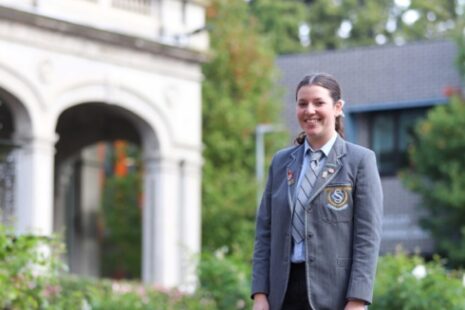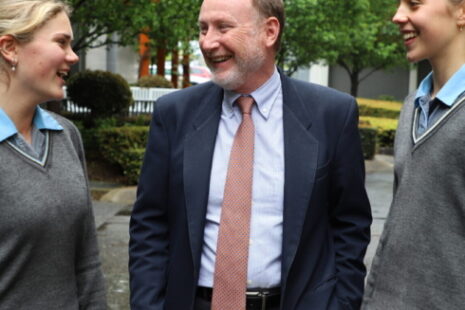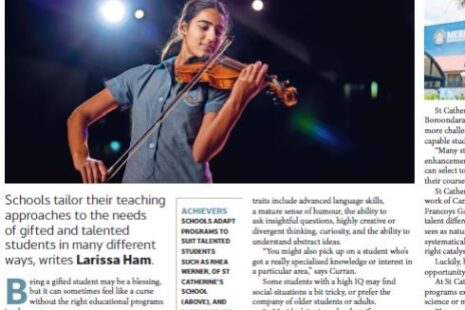The Hand

We teach at St Catherine’s School that Music is historical, mathematical and language-based and most importantly Art
In what might be called a series of fortunate events (no Lemony Snicket here), I have found myself increasingly interested in that incredible part of the human body called the hand.
A simple Google search reveals the hand has 27 bones, not including the sesamoid bone(s), which can vary in number from person to person. Eight are in the wrist, five in the palm which link to the fingers and thumb, and each finger has three bones, with the thumb having two. It is our particular opposable thumb which sets us apart from all other animals, (apparently koalas have two on either side of their hand or paw – necessary for their grasping ability) including our closest relatives the apes, and it seems very likely the hand has been most responsible for the incredible development and capabilities of the brain in humans.
The thumb is undoubtedly the ‘master digit’ of the hand, giving value to all the other fingers, and the ulna and radius could be considered part of the skeleton of the hand because they create further axis of movement with supination (palm facing up) and pronation (palm facing down).
I have taken my hands for granted for many a long year. After all, they subconsciously pick up things, communicate, wash, prepare, draw, grasp, throw, sooth, write, type and – mostly due to my persistent parents who hassled, harried and supported me in a dominant area of interest – play the piano and woodwind instruments. Consider also the surgeon, the seamstress, the athlete, the rock climber, the builder, the dancer and the infinite subsets of these. Some of these tasks require gross motor skills, and some fine motor skills, but all are testament to this most amazing part of the body.
It has been my privilege to attend a number of conferences this year, generously supported by the St Catherine’s School. The first, in the April holidays, was Choralfest, held in Melbourne. With many wonderful speakers and clinicians, the work of Mr Randy Stenson, an American living and working in Tokyo for over 30 years, was particularly interesting to me (my first fortunate event!). He introduced us to the many years work he has undertaken using movement with his choirs, and the reasons for it. In particular, he teaches his choristers to ‘conduct’ their own singing.
In each performance the singer’s personal interpretation of the shape of the melody or phrase is evident. The sound of the choir is free, unrestricted and joyous, and the ownership of the music making is handed over to the individual. As a conductor of musical ensembles I was taught long ago that I needed ‘soft hands’, otherwise any tension would be transferred to the ensemble and result in a strained sound. Certainly, observation over many years has revealed that any tension in singers’ throats seriously impairs the quality of sound achieved, both as a soloist and in an ensemble. Furthermore, if sustained, may lead to serious damage of the vocal chords. A singer subconsciously picks up any tension from the conductor, thus the learnt adage ‘less is more’ has always been of great benefit. What then is the connection between the hand and so many other human functions?
My second ‘fortunate event’ was a particular plenary session at the Sounds Great conference, held at the Victorian Arts Centre. Mrs Daphne Proietto captured the audience of Music teachers with her work as a piano teacher. Daphne has a flock of students with special needs and through piano lessons, she changes their lives. On June 15, 2015 the Herald Sun wrote: “While specialists and doctors tell parents of the things their children will never do – never talk, never do VCE Maths, never be a ballerina – Mrs Proietto has opened the door to a world of possibility.” She has students with autism and cerebal palsy who could hardly move their fingers before commencing lessons. The results of Daphne’s patience, care and belief were evident to all in the plenary session. They played far better than many who have learnt the piano as a passing phase in their ever-busy lives. The joy on these children’s faces was, and is, indescribable. Through her lessons Daphne places her hand(s) over the hand(s) of her students to guide them in the learning of each note. The necessary repetition of patterns we all need to gain mastery had the extra element of touch from the teacher. How often do we wish we could hold a student’s arm or hand so they can experience for themselves the particular ‘effort’ required of any movement? Daphne estimated that one third of the brain is required to ‘operate’ the hand, which was backed up by a little more ‘Googling’ on my part: “Body parts with complex repertories of fine movement, like the hand, require more cortical space.”
In a third ‘fortunate event’, I was cleaning out a bookshelf and found a book called The Hand: How its use shapes the brain, language, and human culture by Frank R. Wilson (Vintage 1999). My first feeling was obviously one of disappointment. Clearly I was not onto anything new with my sudden passion for the hand! However this wonderful book did answer a lot of questions, and pose many more. Wilson writes, “This book has been an inquiry into the premise that the hand is as much at the core of human life as the brain itself.” Further, Wilson asked, “ How does, or should, the education system accommodate the fact that the hand is not merely a metaphor or an icon for humanness, but often the real-life focal point – the lever or launching pad – for a successful and genuinely fulfilling life.”
Wilson quotes Yale psychologist Professor Seymour Sarason who said, “Education can succeed only when it understands that every human being is born with the potential to be creative and artistic.” As a teacher of Music I was happy about that! Unfortunately Sarason also recognised that, “all students learn best and most quickly when self-interest orients and drives the search for information, understanding and skill.” Like so many areas of learning, a detailed study of Music is vast, and beyond what a general classroom education can offer, mostly due to time constraints. In Australia, a study of Music is not universally accepted, despite so many examples of success and off-shoot advantages to all learning around the world.
We teach at St Catherine’s School that Music is historical, mathematical and language-based and most importantly Art. In the words of a much-loved professor from long ago, “everything relates to everything.” We need vocal training for, amongst many things, the development of our ‘ear’ – that sense of excellent pitch and tuning. Wilson writes, “Musical skill is obviously highly correlated with, and dependent upon, refinement of hearing, and the links between auditory perception and human speech and language are so strong that the Darwinian brief for a ‘musical ear’ (is) easily argued.”
But, how important might the learning of an instrument be? Particularly one that requires the use both hands equally, for ultimate left/right brain function, such as the piano or a woodwind instrument, or one which, in the case of a right-hand dominant person, trains the left-hand particularly, such as a string instrument or ‘French’ horn? Wilson writes, “We have now come to a point where we can more fully sense the convergence of the neurologic, linguistic, developmental, and anthropologic perspectives in our world for an understanding of the role of the hand in human life.”
My instinct, and now general research have led me to believe, that the development of fine-motor skills must have a positive effect on the overall development of the brain. My premise is the learning of particular musical instruments is an effective way to maximise the dexterity of the hand, and therefore the effect on the plasticity of the brain. It is of course our ongoing quest at School to support both girls and their families who are interested in Music and who already understand the power of mastery on an instrument, as well as those for whom the ‘self-interest’ is not yet strong. Let us look after our hands, enjoy using them in a myriad of different ways, every day, and develop them as much as possible.
Mrs Jenny Mathers
Head of Music





